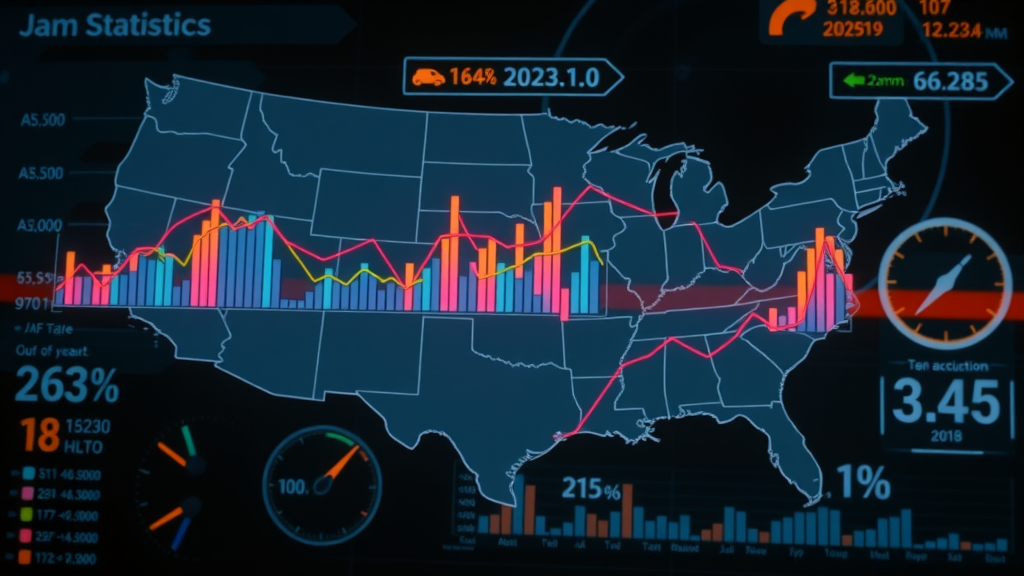
Every 13 seconds, someone is injured in acar accidentin the United States.This jarring fact is just the tip of the iceberg when it comes to understanding car accident statistics. While headlines may tell part of the story, the real data hides dozens of overlooked truths that shape our daily decisions, insurance premiums, and—more importantly—our safety. If you think you “know the numbers,” think again. In this eye-opening exploration, you’ll discover the misconceptions, overlooked patterns, and expert perspectives that most people—and even the news—ignore. Read on to see how these hidden truths could not only change how you view the road but also help save lives.
-
The most surprising and misunderstood car accident statistics
-
Why traffic fatalities aren’t as straightforward as news reports suggest
-
How accident data shapes your insurance rates, driving risks, and safety on the road
-
Simple steps you can take to become a safer, more informed driver
The Hidden Truths Behind Car Accident Statistics
-
Begin with a startling statistic: “Someone is injured in a car accident every 13 seconds in the US.” Explore implications and introduce the theme of overlooked details in car accident statistics.
Car accident statisticsare everywhere—from billboard PSAs to insurance paperwork. Yet, their true significance is often lost in translation. For instance, a crash occurs roughly every thirteen seconds, but what do those brief moments really mean? It’s easy to see such numbers and feel detached, but these figures reflect families, communities, and realities that go unspoken. Moreover, many of the most telling aspects of accident statisticsare buried beneath broad averages and raw totals.
As we sift through the raw data, we find that accident frequencies and outcomes can hinge on circumstances you might not expect: your neighborhood, commute time, or even the model year of your car. Media often highlights shocking totals and fatality rates, but rarely does it uncover the “why” or the hidden variables shaping traffic fatalitiesor motor vehicleincidents. A deeper dive into these stats uncovers a world of everyday risk—often overlooked, sometimes misunderstood, but always affecting how we drive and live.

Dissecting Car Accident Data: What Really Drives the Numbers?
Understanding Motor Vehicle Accident Statistics
-
Breakdown of accident statistics by region, time of day, and type of vehicle (car accident, motor vehicle).
To grasp the full story behind motor vehicle accident statistics, it’s crucial to look beyond totals and inspect the patterns. Statistically, urban areassee more frequent car accidents due to heavier traffic, while rural roadsoften account for higher fatality rates because of speed and limited emergency response. Time of day also wields influence—most traffic crashesconcentrate during rush hour or on weekends, particularly late at night when impaired and drowsy driving spikes.
Different types of vehicles yield unique trends. For instance, crashes involving commercial trucks often have more severe outcomes than typical car accidents. Likewise, motorcycles, despite making up a small percentage of registered vehicles, contribute to a disproportionate number of traffic fatalities. Analyzing these nuances helps legal experts, law firms, and law enforcement focus their case review processes on key risk factors.

Are Traffic Fatalities Really Decreasing? Unpacking Traffic Fatalities Trends
Many news outlets report with optimism that traffic fatalitiesare declining, suggesting improvements in vehicle safetyand enforcement are paying off. Yet, such headlines often hide the complexity beneath. While fatality ratesper million vehicle miles traveledhave dropped over the decades, the absolute number of people killed on the roads recently saw a troubling uptick, especially during periods of fewer vehicles on the road, such as the COVID-19 pandemic.
In truth, changes in reporting methods and evolving definitions of “serious injury” or “fatal crash” can affect year-to-year comparisons. For example, recent research by safety administration groups and researchers and legal experts shows that even as some traffic safety technologies advance, behaviors like aggressive driving or phone distraction have begun counteracting those gains. Thus, to truly gauge progress, we need to read between the lines—evaluating not just news snippets, but context, long-term patterns, and underlying behaviors.
What Most People Get Wrong About Car Accident Statistics
The Role of Human Error in Car Accident Statistics
-
Discuss the common misconception that car crashes are mostly due to hazards outside of human control. Address distracted driving, impaired driving, and decision errors.
It’s a popular myth that car accidentsare predominantly caused by unpredictable hazards: slippery roads, sudden weather, or mechanical failure. However, a deeper look at accident statistics consistently finds that well over 90% of motor vehicle crashes stem from human error. From distracted driving (texting, daydreaming), to driving under the influence, to basic decision mistakes like speeding or not yielding right-of-way, these “everyday” factors are the real root cause.
This revelation is both sobering and empowering. While we may fear the “unknowns” on the highway, the truth is our own choices and those of fellow drivers are far more influential. Such facts get overlooked in shallow accident reports but are crucial for anyone—be it insurers, law enforcement, or drivers themselves—hoping to save lives and reduce traffic fatalities.
Vehicle Safety Measures: Impact or Illusion?
Manufacturers and policymakers often tout technological advances as game-changers for road safety. Safety features like airbags, anti-lock brakes, lane-assist, and automatic emergency braking have undoubtedly saved livesby reducing fatalities and injuries in crashes. However, it’s a misconception that these improvements alone will eliminate accidents or make reckless driving harmless. In reality, studies show that although these features can decrease the consequences of a crash that occurred, they cannot entirely offset bad driving behaviors.
Some research even points out the “risk compensation” effect: drivers in newer, safer vehicles may subconsciously take more risks, offsetting some of the potential benefits introduced by advanced technology. Real traffic safetycomes from pairing engineered solutions with responsible behavior—a lesson at the core of accident statistics analysis.

Connecting Accident Statistics to Everyday Life
How Accident Statistics Affect Insurance Rates and Policies
When insurance companies analyze car accident statistics, they set the foundation for everything from your monthly premiums to your deductible after an accident. But these companies don’t always paint a fair picture: sometimes, they rely on outdated or generalized data, unfairly penalizing drivers living in “high-risk” ZIP codes or fitting certain demographic profiles. Recent accident statistics may highlight “dangerous” areas or age groups, but rarely do they account for safe driving habits or emerging motor vehicle safetytechnologies.
This misreading of accident data means that many responsible drivers pay higher premiums than their habits would justify, or face unexpected rate hikes after a single fender bender. It’s crucial for consumersto demand transparency and nuanced analysis from their insurers—encouraging practices that reward real, on-the-ground driving behaviors instead of outdated assumptions.
Risk Factors Hidden in the Data
Scratch beneath the surface of motor vehicle accident statisticsand a stark truth emerges: not all drivers carry the same risk. Young drivers, particularly those aged 16–24, are hands-down the most likely to be involved in a car accident, largely due to inexperience and risk-prone behavior. Conversely, older adults, while less likely to crash overall, have higher fatality rates when involved due to increased frailty.
Where you live and work also matters. Urban areas, despite their congestion, usually report higher crash totals but fewer deadly accidents due to lower speeds and quicker emergency response. In contrast, rural roadscarry a disproportionate share of fatal traffic crashes, often because of long stretches with high speed limits, fewer safety features, and delayed medical care. Understanding these patterns is crucial—for legal experts, insurers, and anyone hoping to make informed decisions about everyday road safety.

People Also Ask
What is the main cause of car accidents?
According to the latest car accident statistics, distracted drivingtops the list of crash causes, followed closely by impaired driving (alcohol and drugs) and excessive speed. These human-driven factors far outweigh mechanical failures or environmental issues. Their prevalence underlines why targeted campaigns and road safetyeducation remain so important for reducing traffic fatalities.
How reliable are car accident statistics?
Car accident statistics are generally reliable but can be influenced by underreporting, differences in data collection, and evolving definitions of ‘accident’ and ‘fatality.’
Car accident statisticsare widely considered dependable and are used by researchers, law enforcement, and policymakers alike. However, they aren’t flawless: underreporting of minor accidents, differing local definitions (for what counts as a “serious injury” or a “traffic fatality”), and updates to reporting practices can all affect the numbers. Critical thinkers should always check the source and method behind the stats before drawing strong conclusions.
Which age group is most involved in motor vehicle crashes?
Drivers aged 16–24 consistently represent the highest involvement in motor vehicle accident statistics, highlighting the risks among younger age groups.
Teens and young adults—aged 16 to 24—are significantly more likely than other age groups to be involved in a motor vehiclecrash. Their greater likelihood of risky behaviors, combined with inexperience, means they feature heavily in accident reports, insurance claims, and public safety campaigns. Targeted intervention for this demographic is vital for improving traffic safety.
How do vehicle safety features influence accident statistics?
Vehicle safety features reduce fatalities but cannot entirely eliminate accidents due to human error and other risk factors.
While innovations like airbags or anti-lock brakes have unquestionably cut down on fatality ratesand serious injuries in car accidents, technology alone can’t prevent every crash. Human error, inattentiveness, and unpredictable circumstances all continue to play a significant role. Safer cars must be paired with responsible habits for real improvements in accident statistics to occur.
Illuminating the Data: Visualizing Car Accident Statistics
|
Year |
Total Accidents |
Fatalities |
Top Cause |
Region with Most Accidents |
Most At-Risk Age Group |
|---|---|---|---|---|---|
|
2023 |
6,700,000 |
42,795 |
Distracted Driving |
Urban |
16-24 |
|
2022 |
6,620,000 |
42,939 |
Impaired Driving |
Urban |
16-24 |
|
2021 |
6,455,000 |
42,295 |
Speeding |
Rural |
16-24 |
-
Summary of key trends in accident statistics extracted from national databases.
The trends in this table reveal that, despite small fluctuations in total crashes and fatalities, human error—especially distracted and impaired driving—remains the dominant underlying cause. While technology and safer roads matter, demographic factors and driver behavior are the real drivers of change in accident statistics year over year. Notably, young adults consistently rank as the most at-risk, highlighting an area where targeted road safety education could make the greatest impact.

Expert Voices: Perspectives on Motor Vehicle and Traffic Fatalities
“The numbers may be falling, but every life lost in a car accident is a tragedy that statistics alone can’t capture.” — National Highway Traffic Safety Administration
“Safer vehicles don’t mean safer roads if drivers aren’t paying attention.” — Road Safety Analyst
5 Surprising Facts About Car Accident Statistics
-
More car accidents happen close to home than on long trips.
-
Weekend nights have the highest traffic fatalities.
-
The majority of accidents involve vehicles traveling under 40 mph.
-
Accidents are more about behavior than technology.
-
Urban areas, despite congestion, have fewer fatal crashes than rural roads.
These facts challenge much of what drivers think they know. For instance, the common refrain that highways are more dangerous than city streets is untrue; low-speed zones near home are often the real hotspots for fender benders and even serious injuries. Similarly, drivers might be lulled into a false sense of security by modern features and lower speeds, when in fact, behaviors and decision errors remain the prime culprits. Recognizing these subtle truths can help drivers, insurers, and policymakers tackle the root causes of unsafe roads.
How to Correctly Interpret Accident Statistics
-
Guidelines for critical thinking: context, definitions, and pitfalls in analyzing accident statistics; avoiding common misinterpretations regarding car accident and motor vehicle data.
Whenever you see a headline about car accident statistics, remember to ask: What is being measured? Are these raw numbers, rates per population, or per miles traveled? Are changes due to new technology or new reporting standards? Understanding definitions (like what counts as a “fatality” or “serious injury”) and the local context (urban vs. rural, old cars vs. new, weekday vs. weekend) helps you avoid the most common misinterpretations.
Effective analysis also means looking for long-term trends, not just year-to-year shifts. Always compare like with like—otherwise, you risk drawing incorrect conclusions or missing the real issues. For example, a decrease in accidents during one year might be due to fewer vehicles on the road, not safer driving. Critical scrutiny of statistics is a powerful tool for safer roads and more accurate public debate.

Frequently Asked Questions
-
Discuss why accident statistics fluctuate yearly, the effect of advanced safety technologies, and the real meaning behind fatalities versus injury rates.
Q: Why do accident statistics fluctuate each year?
Accident statistics can shift annually due to changes in traffic volume, weather events, economic patterns (fewer commutes means fewer opportunities for crashes), and even reporting practices. Natural disasters, holidays, and public safety campaigns may also impact year-to-year totals.
Q: How do advanced vehicle safety technologies affect accident rates?
Modern safety systems—like lane keeping, adaptive cruise control, and improved airbags—lower the risk of fatal or severe injuries in a crash. However, they can’t counteract all effects of distracted or impaired driving, so continued education and responsible driving remain vital.
Q: What’s more important: reducing fatalities or overall injury rates?
Both are crucial, but focusing solely on one can be misleading. While fewer fatalities (“fatality rate”) signal safer roads overall, high injury numbers suggest there’s still risk in everyday travel. Balanced analysis leads to better policymaking and public awareness.
Key Insights for Safer Roads Based on Car Accident Statistics
-
Share actionable advice: defensive driving, awareness initiatives, and leveraging new data on motor vehicle safety.
To genuinely reduce traffic fatalities, we must combine defensive driving with smart use of technology and ongoing education. Stay attentive, avoid distractions, respect speed limits—even if the latest vehicle safety features feel reassuring. Advocate for clearer data from local authorities and support community safety programs that target at-risk groups. By making these habits routine, everyone helps create safer roads.
Opinion: Why Understanding Traffic Fatalities and Accident Statistics Matters
-
Personal perspective: Informed citizens and policymakers can challenge assumptions, push for better vehicle safety, and improve societal road safety outcomes by embracing the truth in car accident statistics.
As someone who’s spent years working car accident cases, I believe every driver benefits from seeing past the headlines. Accurate data, responsibly interpreted, empowers lawmakers, insurance professionals, and consumers alike to push for real road safetyreform—not just easy solutions. When we question assumptions, follow the numbers, and act on what truly matters, we’re not just preparing case review forms—we’re shaping a safer future for all.
Ready to Rethink What You Know? Improve Your Road Safety Using Car Accident Statistics
-
Encourage readers to become advocates for change—challenge oversimplifications, share accurate accident statistics, and support safety measures that genuinely reduce traffic fatalities and car accident rates.
Take the next step beyond awareness: question simplifications, champion real reforms, and share trusted accident statistics with your community. Road safety isn’t just an issue for experts or law firms. By demanding truth, supporting proven safety initiatives, and being mindful on the road, every driver becomes part of the solution.
Conclusion
Adopt defensive habits, seek reliable accident data, and advocate for smart policy—informed action is key to reducing car accidents and traffic fatalities. Every step matters on the road to true safety.






